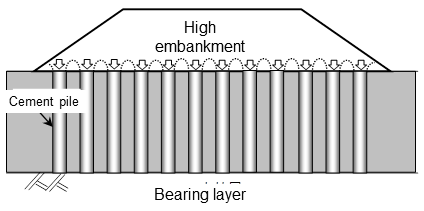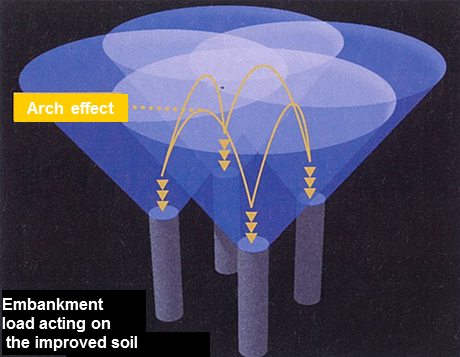ALICC Method for Long-Term Control of Subsidence of Soft Ground

Deep mixing soil stabilization

Conventional ground improvement

Ground improvement by ALICC
(Area and volume to be improved can be reduced.)

Concept of arch effect
(The appropriate pile interval can be designed.)
1. ALICC (Arch-action Low Improvement ratio Cement Column) Method
When roads are built in Japan, high embankments are often constructed on
ground which contains very deep soft soil layers. Serious subsidence is
likely to occur to those roads and affect the surrounding houses or farmland.
As a solution, deep-mixing soil stabilization, a technique to inject cement
into the ground and agitate it to form cement piles and build the foundation
for the embankment above the ground, is often used to improve the soil.
But the conventional procedure, which constructs cement piles mainly on
the slope of the embankment, requires a wide area or a greater volume for
improvement, and therefore is very costly.
Considering these circumstances, the team developed ALICC, a new soil improvement
method that features the use of the arch effect to realize a reduction
in area or volume for improvement. Incorporation of the arch effect into
the design allows for improvement of the ground entirely under the embankment
at an equal interval. Reduction in cost and construction period is thus
realized by reducing the area or volume for improvement.
2. Arch Effect
ALICC is based on the design theory that the phenomenon of stress concentration,
in which the embankment load acts on cement piles as the embankment builds
up, is assumed as the embankment load acting in an arch-like way. Application
of this theory allows us to determine appropriate intervals relative to
the strength of the ground or embankment and realize more economically
efficient design.
This method is currently used in various parts of Japan. We intend to continue
diffusing technologies in the future.
(Contact: Construction Technology Research Team)
Engineering Manual for Construction and Management of Roads and Other Structures
on Peaty Soft Ground Published
Manual on Countermeasures for Peaty Soft Ground revised in March 2011

Typical Hokkaido fibrous peat

Road surface unevenness caused by
long-term settlement of soft peaty ground
What is peaty soft ground?
Peaty ground is found widely in cold areas. It is produced when reeds,
sedges and other plants in marsh, lake and other wetland habitats fall,
decay and accumulate. Under certain topographic conditions characterized
by low temperatures and high humidity, naturally accumulating layers of
partially decomposed plants begin to build up to form peaty ground. In
Japan, massive peat bogs are found in Hokkaido and Aomori, with smaller
ones dotted around the country. The peat layers frequently seen in Hokkaido
are approximately 3 - 5 m in thickness, and sit on top of accumulated soft
clay layers often measuring more than 20 m in thickness. Soil with an accumulation
of peat in the top layer and a thick accumulation of soft clay below is
referred to as peaty soft ground. The existence of the thick clay layer,
in combination with the distinctive characteristics of peat, makes it more
difficult to work with this type of ground.
Characteristics of peat
The plant fibers in peat are interwoven, forming a sponge-like material
with the consistency of a loofah. Peat is seen as a distinctive soil that
is wholly different from other types. Its high porosity makes it very water-retentive,
meaning that even light loads can cause major immediate deformation in
addition to the worse problem of long-term settlement. As peat is also
particularly low in strength, it can collapse under the weight of earth
piled on it.
Key points in the revision of the manual
As outlined above, peat has a unique set of characteristics, meaning that
standard methods cannot be applied in related testing, surveying and analysis.
Against this background, the considerable expertise and the body of study
results obtained so far were summarized to create standards for testing,
design and construction relating to peat. These were published in the form
of the Manual on Countermeasures for Peaty Soft Ground in March 2002.
The March 2011 revision focused on the reduction of life cycle costs, including
those incurred in construction and maintenance related to embankments on
peaty soft ground. For the construction of roads that allow safe, convenient
travel over peaty soft terrain, appropriate measures based on the predicted
extent and duration of settlement are needed. In this regard, a method
to accurately calculate long-term settlement in such ground - a task previously
considered extremely difficult - was developed. In addition, information
on countermeasures involving improved design and construction management
methods as well as new survey and design techniques that take seismic factors
into account were added to the manual in order to enhance its content.
CERI’s Geotechnical Research Team plans to continue studies related to
peaty soft ground and share information on practical technologies as needed.
We hope the manual will help engineers in the field as a useful technical
guide, and that it will become even more widely used.
(Contact: Geotechnical Research Team,CERI)
